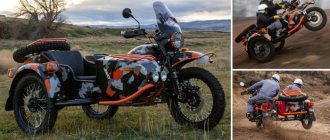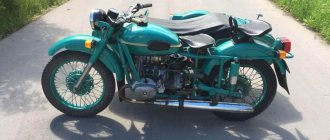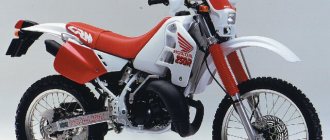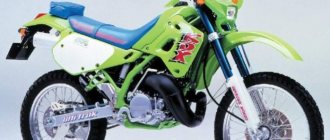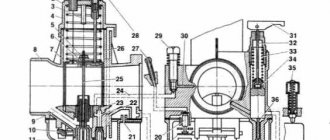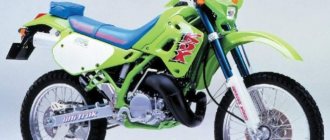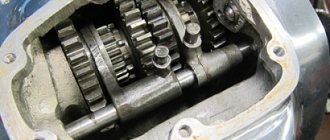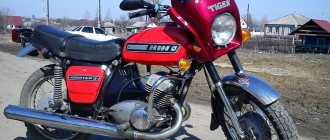The Japanese scooter Honda Gyro X is a fairly fast, but extremely safe tricycle that is suitable for both experienced riders and beginners. Thanks to the automatic transmission and three wheels, almost any adult and even a teenager can drive it. Japanese scooters are very reliable, therefore, with proper careful handling, they do not require special maintenance. It is enough to follow the simplest instructions, and the scooter will serve you for many years.
All Japanese scooters of the “Gyro” series, by the way, produced since 1982, have a skewing mechanism, which consists of two parts: front and rear. The scooter body (the main front part), through a movable articulated base, rests on a rear bogie, consisting of a 50 cm³ gasoline engine and two rear wheels. When maneuvering, the rear trolley does not change its position relative to the road surface, and the main part of the scooter tilts towards the turn.
The three-wheeled scooter Honda Giro X is, first of all, high Japanese quality and practicality, comfort and functionality. Cost-effectiveness, stylish exterior, comfortable driving position and ease of operation, excellent stability while driving, the presence of a small front and spacious rear trunk, as well as many other advantages, make this compact scooter an equally effective vehicle in urban environments and in rural areas.
Companies that require prompt courier delivery are often keen to buy a new Honda Gyro X scooter. These companies include small cargo delivery companies: online stores, pizzerias, restaurants, cafes, sushi bars, etc. For an ordinary citizen, the price of a three-wheeled scooter without mileage is decent, but for a commercial organization it is quite acceptable. However, private buyers should not despair, because you can always buy such a used scooter.
Our online store sells new Honda Giro X scooters on order. After making an advance payment, the buyer will need 30-40 days of waiting. This is exactly how much we will need to deliver the scooter from Japan. For those who don’t want to wait, we can offer used tricycles of this model at a lower price, with our proprietary pre-sale preparation, during which all consumable parts are replaced with original new ones, including oils and operating fluids.
The single-seater Honda Gyro X 50 scooter will not disappoint its owner. The low-pressure rear wheels allow the scooter to be used on country dirt roads, not excluding the winter period. Having a scooter on three wheels in a village, in a country house or for a resident of a small village is very convenient and practical. The speed of 60 km/h, by the way, is limited to this value to increase safety, and two trunks allow you to quickly move short distances and transport light loads.
Honda Gyro
- a family of compact three-wheeled scooters designed for one person. The main market is Japan, where scooters are used as courier transport.
This scooter is a three-wheeled vehicle equipped with a skew mechanism - the engine and rear wheels are located in the rear bogie, which rests relative to the road surface when in motion, while the rest of the body is suspended on a movable hinge and tilts towards the turn when maneuvering. This arrangement was developed and patented by George Wallis of GLWallis & Son in Surbiton, Surrey in 1966. The patent was first used in the production of the failed BSA Ariel 3 in 1970, then resold to Honda.
In total, Honda built seven models of this layout. The first of them is Stream
- was introduced in 1981.
the Joy
,
Just
and
Road Fox
models were produced - these were versions intended for use as personal transport.
Their production was relatively short-lived, but in 1982 the truck-oriented Gyro line was released, which included the Gyro X
,
Gyro Canopy
and
Gyro Up
. It fit well into its target audience, thanks to which all three models of the line were produced until recently.
It is noteworthy that for a long time all these models were produced with 49 cc two-stroke engines, unlike other Honda models equipped with four-stroke engines of similar displacement. This is due to the need for more power in scooters with engines up to 50 cc, which are allocated in a separate class in Japan (similarly in Russia). It wasn't until March 2008 that the Gyro X and Gyro Canopy began to be equipped with four-stroke engines, and the Gyro Up was discontinued.
Honda Gyro
The Honda Gyro cargo tricycle, which first appeared in 1982, does not seem like anything legendary. However, even in Russia there are plenty of owners of this funny three-wheeled thing, and in Japan it is one of the most popular models of commercial vehicles.
A three-wheeled cargo moped sounds funny, but in fact, a correctly configured variator, small wheels and a clever hinge dividing the moped into two halves - an inclined one with the front wheel and a tenacious two-wheeled rear one - turned out to be so in demand that Honda released an entire line, including the Gyro Up, Gyro X and Gyro Canopy.
Almost all the time, these mopeds were equipped with a two-stroke engine, and only in 2008 Honda switched to four-stroke 50 cc engines.
Also in 2008, the Gyro Up was discontinued, but the basic version X and the funniest version, with a roof, Canopy, are still produced to this day. And now the Gyro e, equipped with an electric drive, has also appeared in the Honda Gyro family.
Ural Gear-Up: an expensive toy from the past. Our test
I have never seen so many admiring glances and raised hands in greeting! In Moscow, a Ural with a stroller attracts such attention that even a self-propelled bathtub with strippers inside and bears playing on balalaikas would not receive. Why then doesn't anyone buy it?
It was born in Germany in the late 30s as the BMW R71. Shortly before the start of the war, it was completely copied by Soviet engineers at the Moscow Motorcycle Plant (MMZ), but as the Germans approached the capital, production was evacuated to Irbit, where the motorcycle, called M72, had already begun to be assembled in series.
The restored original BMW R71, in my opinion, looks no worse than the Urals (photo by Mikhail SHESTAKOV)
I remember Irbit motorcycles from school - one of these stood like an indestructible pedestal on the ground floor of a department store next to the grocery department and cost a whopping 1,800 rubles! Moreover, the Ural, unlike cars, was sold freely, without ten-year queues - a kind of socialist ersatz car for those who dared to dream of personal transport.
The good old air-cooled boxer engine has not changed fundamentally - except that it is equipped with an injection system and electronic ignition
After the collapse of the USSR, the Irbit plant went through difficult times: if once more than ten thousand people worked at the enterprise, now there are just over a hundred. But Urals are still produced! The power of the boxer engine has been increased from 36 to 41 hp, the fuel injection system is entirely Bosch and Delphi components, and there are also Sachs shock absorbers, Brembo disc brakes (all around, including the sidecar), Ducati Energia electronic ignition, Denso generator, Yuasa battery , Marzocchi steering damper (Bitubo is used on the 2018 model), NGK spark plugs and high-voltage wires, Herzog gears and shafts, SKF bearings...
• Sachs preload-adjustable shock absorbers are quite tight even in the most comfortable position • Steering damper in the Urals with the ability to change force? Yes, this is also a factory option
What is left of ours, Russian? Frame, sidecar body, engine crankcase, wheel rims and spokes, heavy “accessories” (footrests, gear shift and reverse feet), cardan shafts... It’s not surprising that such a Ural costs about 800 thousand rubles.
How's it going?
The ergonomics still come from pre-war Germany: the cylinders sticking out on the sides leave almost no legroom. The traction at the bottom is tractor-like: the motorcycle never got a tachometer, but the highest, that is, fourth, gear becomes operational already from 40 km/h. However, the engine still turns sour on the slightest inclines: it is difficult for it to carry a vehicle with a curb weight of 365 kg.
The full version is available only to subscribersSubscribe now
I'm already subscribed
Honda Gyro E
Like its petrol siblings, the Honda Gyro E has a three-wheel configuration, essentially consisting of two halves. The front end ends approximately where the engine and variator begin on a regular scooter. The rear one, two-wheeled, not only contains the engine, but also is the basis for the cargo platform. The joint connecting the two halves turns easily, allowing the front to lean into corners like a regular scooter, while the rear, with two wheels and a differential between them, provides good grip on the road when cornering. There are arches on the luggage platform, which are convenient for hooking luggage straps, and another small luggage rack can be purchased as an option and placed in front, directly above the low-mounted headlight.
Variations of the Honda Gyro
Honda Gyro X
| Honda Gyro X | |||||||||||
| Honda Gyro X | |||||||||||
| general information | |||||||||||
| Other names | |||||||||||
| Components | |||||||||||
Engine
| |||||||||||
| checkpoint | |||||||||||
| Specifications | |||||||||||
| Tank capacity | |||||||||||
| Dimensions | |||||||||||
| Motorcycle base, mm | |||||||||||
The first model of the Gyro line was presented to the public in October 1982. It was equipped with front and rear luggage areas. The rear bogie is equipped with two small low-pressure wheels, a differential with increased internal resistance for difficult roads and a parking brake. According to some reports, by May 2002, 135,226 scooters of this model were sold.
Honda Gyro UP
| Honda Gyro UP | |||||||||||
| |||||||||||
| general information | |||||||||||
| Other names | |||||||||||
| Components | |||||||||||
Engine
| |||||||||||
| checkpoint | |||||||||||
| Specifications | |||||||||||
| Tank capacity | |||||||||||
| Dimensions | |||||||||||
| Length, mm | |||||||||||
| Width, mm | |||||||||||
| Motorcycle base, mm | |||||||||||
Honda Gyro Canopy
| Honda Gyro Canopy | |||||||||||||
| |||||||||||||
| general information | |||||||||||||
| Other names | |||||||||||||
| Components | |||||||||||||
Engine
| |||||||||||||
| checkpoint | |||||||||||||
| Specifications | |||||||||||||
| Tank capacity | |||||||||||||
| Dimensions | |||||||||||||
| Length, mm | |||||||||||||
| Width, mm | |||||||||||||
| Height, mm | |||||||||||||
| Motorcycle base, mm | |||||||||||||
| Ground clearance, mm | |||||||||||||
From the time of this news until the end of the campaign, all of Kutuzov’s activities consisted only in using power, cunning, and requests to keep his troops from useless offensives, maneuvers and clashes with the dying enemy. Dokhturov goes to Maloyaroslavets, but Kutuzov hesitates with the entire army and gives orders to cleanse Kaluga, retreat beyond which seems very possible to him. Kutuzov retreats everywhere, but the enemy, without waiting for his retreat, runs back in the opposite direction. Historians of Napoleon describe to us his skillful maneuver at Tarutino and Maloyaroslavets and make assumptions about what would have happened if Napoleon had managed to penetrate the rich midday provinces. But without saying that nothing prevented Napoleon from going to these midday provinces (since the Russian army gave him the way), historians forget that Napoleon’s army could not be saved by anything, because it already carried in itself the inevitable conditions death. Why is this army, which found abundant food in Moscow and could not hold it, but trampled it underfoot, this army, which, having come to Smolensk, did not sort out the food, but plundered it, why could this army recover in the Kaluga province, inhabited by those the same Russians as in Moscow, and with the same property of fire to burn what they light? The army could not recover anywhere. Since the Battle of Borodino and the sack of Moscow, it already carried within itself the chemical conditions of decomposition. The people of this former army fled with their leaders without knowing where, wanting (Napoleon and each soldier) only one thing: to personally extricate themselves as soon as possible from that hopeless situation, which, although unclear, they were all aware of. That is why, at the council in Maloyaroslavets, when, pretending that they, the generals, were conferring, presenting different opinions, the last opinion of the simple-minded soldier Mouton, who said what everyone thought, that it was only necessary to leave as soon as possible, closed all their mouths, and no one , even Napoleon, could not say anything against this universally recognized truth.
Honda Gyro Canopy is a three-wheeled Japanese moped with a roof for transporting goods and people. The scooter is able to protect the driver from precipitation and exposure to negative weather conditions. Widely used for commercial purposes for transporting small luggage (for example, pizza).
Among the advantages of the Honda Guro Kanopy over its analogues are:
- 50 cc engine - reliable, economical, traction;
- The case is larger in volume than most competitors;
- Canopy - adds the ability to operate the scooter in the rain;
- Three wheels increase the stability of the motorcycle.
Honda Gyro E range
At the same time, the new Honda Gyro E is equipped with a modern version of the electric drive, including a system of replaceable batteries, Honda Mobile Power Packs, in the amount of two pieces. The batteries, located under the single seat, can be easily removed and replaced with freshly charged ones. When paired, they produce 96 volts of voltage, provide a range of 72 km (when driving at a speed of 30 km/h) and recharge in 4 hours.
Fast recharging and battery swappability keep the Gyro e on the go all day long.
Review
Honda Canopy has a nondescript appearance. Behind the driver's seat there is a high-capacity trunk. The trunk is equipped with a convenient locking mechanism and a moisture protection function. You can easily fit medium bags inside.
The Canopy Combo scooter consumes only 2.5 liters of fuel per 100 kilometers. This makes it possible to use the scooter throughout the year without fear of running out of fuel or lack of other resources.
Like other scooters from the Japanese manufacturer, this model also underwent tuning and modernization. Depending on the year of manufacture, they were equipped with TA-03, TA02 engines and their modifications. This entails a difference in some technical characteristics from the basic ones.
Specifications
| Length | 1895 mm |
| Width | 660 mm |
| Full Height | 1690 mm |
| Seat height | 769 mm |
| Base | 1410 mm |
| Clearance | 170 mm |
| Speed max | 60 km/h |
| Oil tank | 1.2 liters |
| Gasoline tank | 7.3 liters |
| Weight | 120 kg |
| engine's type | TA03E |
| Fuel system | Injection |
| Cooling | Liquid |
| Working volume | 49 cm3 |
| Number of cylinders | 1 |
| Number of cycles | 4t |
| Cylinder diameter | 40 mm |
| Piston stroke | 39.3 mm |
| Power | 5.0 hp at 6500 rpm min. |
| Torque | 5.7hp at 6500 rpm min. |
| Start | Kick and electric starter |
| Drive unit | V-belt variator |
| Number of gears | 4 |
| Compression | 5,2 |
| Manufacturing city | Tokyo |
How much does it cost and where to buy
The Honda Giro Canopy moped ceased production in 2012, so at the moment you can only purchase a used scooter. The average price range in the city of Moscow depends on the modification of equipment and its technical condition. Average figures are settled in the range from 90 to 120 thousand rubles
. Popular banks issue loans for purchases on favorable terms without any problems. Transport companies that cooperate with specialty stores can deliver your purchase to your home.
Prices for a used moped in Ukraine range from 450 to 950 dollars. The purchase can be delivered to your home or by Autolux.
Spare parts
Average cost of components for a Honda Canopy moped.
Description
